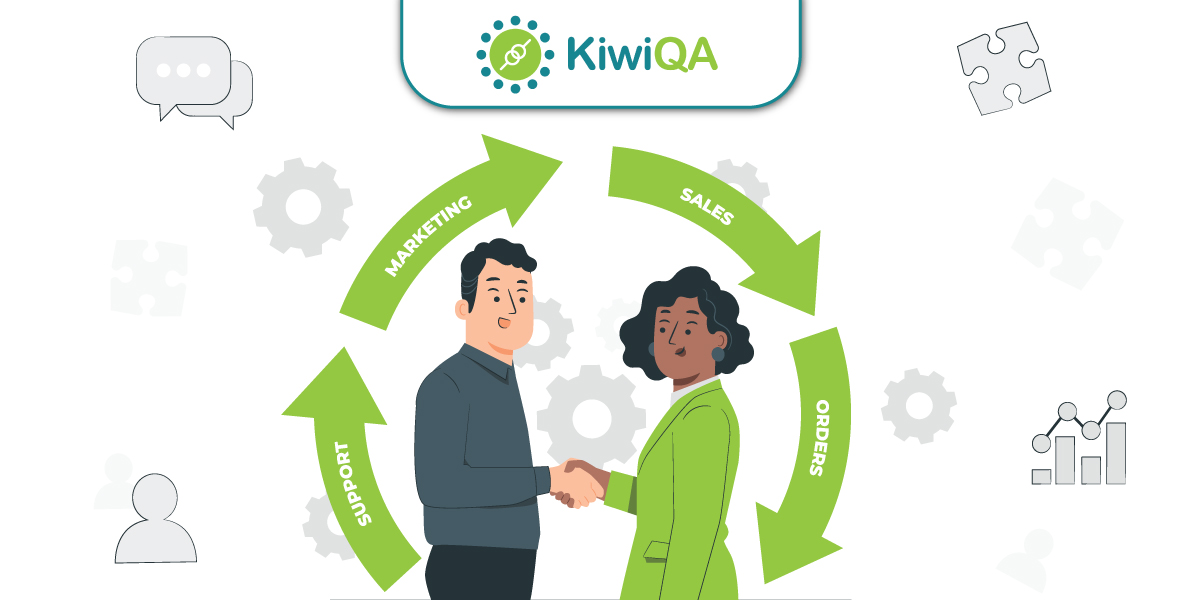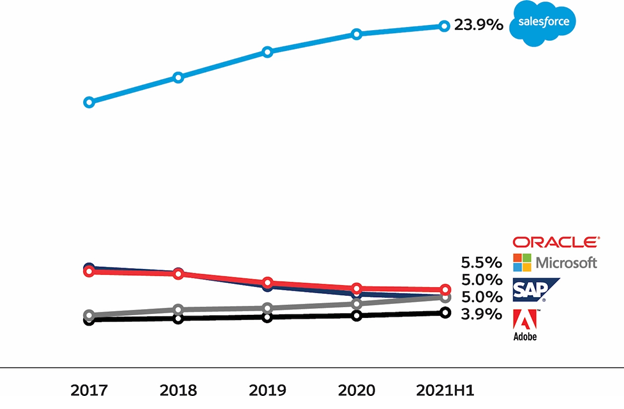CRM (Customer Relationship Management) software is used by all types of businesses for managing relationships with their existing, as well as, potential customers. When it comes to choosing the best-suited CRM, businesses have a number of options like Zoho, Freshdesk, Salesforce, SAP, amongst others.
It is a no-brainer that every business (irrespective of the scale) requires some sort of CRM for customer retention and customer acquisition. In this over-crowded market, Salesforce is still ranked as the #1 CRM provider as per 2021[1] IDC report.
CRM comprises a number of applications – sales applications, customer service applications, marketing applications, and enterprise community applications. Since customers and agents are an integral part of the Salesforce CRM cycle, it becomes imperative to perform Salesforce CRM testing for providing a top-notch customer experience.
In this blog, we will touch upon the integral aspects of Salesforce CRM testing – particularly Salesforce automated testing. The learnings of the blog will be useful in creating a long-lasting positive experience for the customers. So, let’s get started…
Key Terminologies Of Salesforce CRM Testing
Before deep diving into aspects related to Salesforce testing, let’s learn about the key terminologies related to Salesforce CRM:
● Accounts
Accounts indicate the working relationship involved between different entities of the business. The entity could be customers, partners and/or competitors.
● Salesforce Objects
These are database tables that let administrators and other authorized personnel create, store, and update data that is specific to the organization.
● Salesforce Custom Objects
These are items that do not come in-built with Salesforce CRM, but are created by the organization (or client) using the CRM.
● Records
Like any other CRM, records consist of fields that hold information about a particular item. For example, a master customer record will have fields like name, surname, mobile number, email address, and more. The record can have a primary (or unique) field using which detailed information related to the record can be fetched for performing further operations.
● Case
Case indicates the complaint (or feedback) that might have been shared by the customer(s).
● Dashboard
Akin to any other form of software, the dashboard lets the respective stakeholders deep dive into integral aspects of the products, customers, etc. by presenting the information in the form of charts, graphs, or any other visual representations. This information is generated from the respective reports of the organization.
● Leads
The purpose of any business is to onboard (or acquire) new customers while retaining the existing ones. Every customer (existing or prospect) is considered as a Lead. CRM is an effective tool for lead generation & lead management.
Apart from these, the other important Salesforce CRM terminologies that you should be aware of are: Activity, Products, Folders, Forecast, and Opportunity.
Stages of Salesforce CRM Testing
Like any other software product, Salesforce CRM testing must also be performed at different levels, i.e. Unit testing, Integration testing, User Acceptance Testing (UAT), Verification testing, and Regression testing.
For starters, Apex[2] is the programming language based on the object-oriented principles that enables developers to execute flow and transaction control statements on the Salesforce Platform server.
Here is the gist of the different stages of Salesforce testing:
● Unit Testing
Like any other form of software, unit testing in Salesforce is conducted by the Apex Developers. The developers write the necessary clauses that help in testing the overall coverage.
Using unit testing on Salesforce CRM, developers get a detailed understanding about the affected records. This information will be used to decide whether the code can make it to the production environment (or not).
In ideal cases, the minimum coverage should be 78 percent – only then the Apex code can be deployed to the production environment.
● System Testing
Unlike unit testing where the Apex developers performed the tests, development and execution of system tests require much more domain expertise. This is the primary reason why system testing of Salesforce CRM is performed by the Salesforce consultants.
Their deep-rooted domain understanding is helpful in verifying every aspect of the code (or business flow). The system’s technical processes are verified from start to finish.
Automated Salesforce CRM testing can come handy in performing system tests. Since the tests are written taking the entire system into consideration, it helps in identifying issues in critical business rules like workflows, assignments, and more.
● Regression Testing
Salesforce CRM is also like any other form of software that consists of features and functionalities that must be inline with the client requirements. Hence, it should also undergo regression testing.
Salesforce regression testing is conducted by the system users (or system testers) for ensuring that the newly developed code and configuration features are not impacting the existing processes in the system. The release will be halted in case the regression tests do not result in a pass.
● User Acceptance Testing (UAT)
As the name indicates, Salesforce UAT is the process that lets the Salesforce consultants decide whether the desired version of CRM meets the required business needs. Only if all the requirements are met, the software can be deployed to the production server.
Salesforce UAT must always be included in the Salesforce test plan since the clients and/or end-users will also be a part of the testing process. If the necessary stakeholders give a green signal to the release, it means that the CRM has fulfilled all the needs from a business standpoint.
● Product Verification Testing
This form of testing is very much similar to system testing except that the testing is performed on CRM deployed to the production environment. Salesforce consultants and clients and/or end-users are a part of the product verification testing process.
If the product verification testing (or production testing) results in a pass, it means that configuration and code can be deployed safely from the Salesforce UAT sandbox to the production environment. The end-users must take additional effort to conduct production testing on the live production environment.
Also Read – 7 Best Practices for Salesforce Testing
Best Practices of Salesforce CRM Testing
In the interest of time, we would not be covering every aspect of Salesforce testing. Or should we say that those topics can be a part of the broader Salesforce tutorial series.
Having said that, here are some of the best practices when it comes to Salesforce CRM testing:
● Create a detailed Salesforce test plan
Like any other form of software testing, it is essential to have a detailed test plan. The Salesforce test plan must be created by the Apex developers, architects, and Salesforce consultants.
The test scenarios must take into account all the major requirements from a business standpoint.
● Always use a valid user profile
In a CRM, every user profile has different access permissions. This helps in ensuring that the features are not only fully functional but also adhere to the necessary security standards.
Hence, Salesforce CRM testing must be performed with valid user profiles so that features can also be tested from a security standpoint.
● Consider corner test scenarios
Corner cases must be considered for ensuring that the features are tested holistically. System testing and UAT (User Acceptance Testing) must be performed taking the end-user persona into consideration.
For all the test scenarios, you must compare the execution status with the expected outcome. The changes cannot be deployed to the production environment in case this particular testing results in a failure.
● Prioritize test management
A CRM system comprises a number of complex blocks that are responsible for delivering features aligning to the business processes. The Salesforce CRM test plan must clearly mention the priority of the test scenarios that are inline with the business requirements.
This helps in ensuring that the high priority test scenarios are given execution preference in comparison to the non-important scenarios.
Conclusion
Salesforce CRM is one of the leading CRM software(s) used by different types of businesses. It has an active community of developers and testers, the core pillars of the Salesforce CRM ecosystem.
Since Salesforce is immensely popular, enterprises using Salesforce CRM must take additional effort to perform testing at scale. Selenium, Tricentis Tosca, and Micro Focus Unified Functional Testing are some of the widely-used Salesforce automated testing tools.
To make the most out of Salesforce CRM testing, it is essential to partner with an outsourced QA vendor like KiwiQA that has a dedicated team of Salesforce CRM testing experts – a key pointer that can accelerate production deployments.









